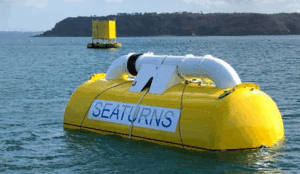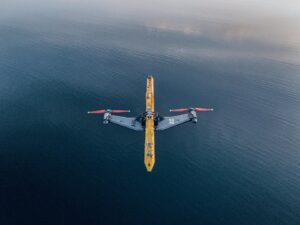Omar Shah from our National Centre of Tribology attended the All Energy 2025 conference in Glasgow last week, engaging with engineers, innovators, and investors across the renewable energy sector. A recurring theme was the extreme and often unpredictable loading conditions imposed by fluctuating natural resources – conditions that place significant demands on turbine components, particularly bearings. These challenges call for intelligent bearing design, material selection, and lubrication strategies. In this article, we explore how these tribological issues arise in a few of the projects we learnt about and examine approaches to managing and mitigating them.
Seaturns: pulsating load in wave power
Seaturns is a wonderfully elegant approach to wave power that avoids many of the challenges of the field through its simple and robust design. Waves drive oscillations in a working fluid that pumps air through a turbine. A neat aspect of the concept is that the air-flow is driven in one direction only, so it doesn’t have to change direction.
One challenge that is faced by many wind and wave power systems, including this one, is the varying axial load on the turbine imposed by each wave cycle. Stormy seas could cause axial shock loading, meaning that bearings must be selected to avoid issues such as those seen in this LinkedIn post. The use of SiN rolling elements, or using a tapered roller bearing instead of ball bearings, are two approaches we have seen used elsewhere. Even in calm seas, pulsating load is a harsh condition, promoting skidding of the rolling elements and elevated cage wear, which must be considered in the selection of lubricants and cage materials.

Figure 1: Image of a working scale prototype, courtesy of Seaturns
Norhybrid: moment loads in vertical-axis wind turbines
Conventional ‘windmill’-style wind turbines take up a lot of space and must be built on a tall mast to give sufficient clearance above the ground. For small-scale applications, this can make a wind turbine an unattractive proposition. Vertical-axis wind turbines like Norhybrid’s product provide an alternative for these situations. Another bonus is that they can take advantage of wind from all directions without having to include a separate yaw bearing, which can be a common source of trouble in conventional turbines.
However, the vertical-axis concept comes with its challenges: the rotation axis of the rotor is no longer coincident with the wind force vector, which leads to a high moment load on the rotor main bearing. If improperly sized, a number of issues can arise, including ball truncation or skewing of the rollers and cage failure. Norhybrid appear to address this by using a main bearing that is quite large compared to the size of the turbine to increase moment-carrying capacity. Other turbines, including the largest such turbine in the world, use cable stays and an additional bearing at the top, but this eliminates many of the advantages of the vertical axis. Ultimately, the moment load puts an upper limit on the practical size of vertical-axis wind turbines.

Figure 2: The largest vertical-axis wind turbine in the world, in Cap-Chat, Quebec, from ChristianT, Wikimedia Commons, CC-BY-SA 3.0
Orbital: resolving corrosion in tidal power
Orbital Marine’s eye-catching design looks halfway between a submarine and an aeroplane. It operates large rotors underwater in tidal flows. While running a propeller underwater is nothing new – the first screw-driven steam ship was built in 1839 – this application faces some unique design constraints. The usual solution to this problem is a long ‘stern-tube’ bearing, with multiple seals, and a pressurised oil system. In this case, the tide flows in both directions, so going one way, the water needs to get past the nacelle to reach the rotor. Therefore, it is important to minimise the size of the turbine assembly.
We understand that Orbital have worked with bearing manufacturers to develop a custom bearing solution, allowing them to carry high loads in a compact space. Any ingress of water could cause corrosion of the raceway, ultimately leading to premature fatigue failure, so excellent sealing is required to keep the water out under dynamic conditions. There are a few ways to achieve this, ranging from multiple redundant contact seals at the low-tech end to pressurised grease systems and even fancy ferrofluid seals in some high-tech applications. We don’t know what approach Orbital have used, but their second-generation system has been in operation since 2021, so it looks like it has worked!

Figure 3: Orbital Marine Power’s O2 system, from S.clarkorbital, Wikimedia Commons, CC-BY-SA-4.0.
These examples highlight just a few of the exciting projects on show at All Energy, Glasgow, and the tribological challenges they face. As the renewable sector continues to innovate, the role of intelligent mechanical design, and especially bearing design, will be critical to ensuring reliability, longevity, and cost-effectiveness. At the National Centre of Tribology, we’re excited to support the sector with advanced modelling tools like our in-house bearing analysis codes (including, CABARET a state-of-the-art bearing code used extensively in the space industry), practical experience of the design and operation of critical bearing systems, and a deep understanding of how materials and components perform in demanding environments. By working closely with developers, we can help turn promising concepts into commercially viable technologies that stand the test of time, and the elements.
For any further information or enquiries, email us at info@esrtechnology.com or via our website contact form.